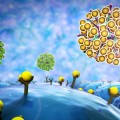Developing bio-based carrier systems for gene transferGenes on sugar - von Prof. Dr Dagmar Fischer, Prof. Dr Thomas Heinze
The targeted transport of DNA and RNA using vectors (mostly made from synthetic polymers) in cell cultures has become part of routine practice in biological R&D – a fact highlighted by the multitude of commercial kits now available. To date, however, obstacles relating to use in patients have beset many laboratory studies and – in particular – the transfer to clinical practice. In many cases, such issues are related to safety concerns and limited...
 Metal-organic frameworks: record-breakers in porosityThe search for endless emptiness - von Prof. Dr Stefan Kaskel
In recent years, metal-organic frameworks have been setting one record after another in relation to specific surface area, with over 7,000m2/g now being achievable. Their modular construction and the large number of functionalities that can be built into the lattice make them both interesting and highly promising for a wide variety of applications.
 Environmental microplasticsA danger to human health? - von Prof. Dr. Gerd Liebezeit
Humans create their own environment and since the 1950s, this has increasingly included products made from synthetic polymers, commonly referred to as "plastics". Plastic waste in the environment is probably here to stay for decades – if not centuries. But can we actually remove plastics – and microplastics in particular – from the environment?
 Using functional polymers in porous structures for transport controlSwitchable nanochannels - von Ass. Prof. Dr. Annette Andrieu-Brunsen
Can molecular transport be controlled by nanoscale pores? In both human technology and Nature, many transport and separation processes are based on pores and porous materials. If transport needs to be time-controlled and separation based not merely on size, it becomes necessary to combine pores of a certain size with switchable chemical functions or polymers.
 What can analytics tell us?Nanoparticles in food - von Dr Philipp Brüning
Over the last few years, legislation specifically governing the handling of nanomaterials (NMs) has been steadily expanded within the EU (Fig. 1). One example is the Food Information Regulation, which requires that food ingredients in the form of “engineered nanomaterials” must be clearly indicated in the list of ingredients. To produce accurate labelling – and to inspect and assess this labelling – clear definitions are required, alongside...
 Combinatorial explosion in the separation sciencesvon Prof. Dr. Gérard Hopfgartner
In the analytical sciences one of the major goals is to develop and validate methods for the identification and quantification of molecules in complex samples, in order to support investigations in the pharmaceutical sciences, environmental sciences, food sciences, biology and medicine. A typical workflow consists in isolating the analyte from the matrix, separating it from other similar constituents and selectively identifying them. One of the...
 How can we safeguard the quality of our beer?From the barley to the bottle - von Prof. Dr Michael Rychlik, Katharina Hofer, Dr Martina Gastl, Katharina Habler, Cajetan Geißinger, Dr Michael Hess
Beer is an integral part of German culture. Not only because of the German "Beer Purity Law" (Reinheitsgebot) it is that we associate the drink with concepts such as “traditional”, “wholesome” and “additive-free”. As a cereal product, however, beer is subject to the same conditions that affect the cultivation, storage and processing of other cereal crops. One of the problems with which almost all cereal products are confronted is...
 Tracking down the secrets of photosynthesisMini solar power stations - von Prof. Dr Athina Zouni, Prof. Dr Frank Müh
During photosynthesis, water is converted into oxygen, transforming sunlight into chemically usable energy. The precise details of the mechanisms behind this solar-powered splitting of water remain unknown and are now being investigated with advanced techniques in structural analysis. This work requires the availability of high-quality crystals of the all-important protein complex, photosystem II, whose growth poses several challenges...
 Food safety as a global challengeWhat makes something “authentic”? - von Prof. Dr Markus FischerImage-based cytometry – a technology conquers cell cultureStar charts and Petri dishes - von Dr Daniel H. Rapoport, Dr Tim Becker
Cell cultivation has now become an indispensable part of scientific investigation and applications within medicine. From a simple substance test to the autologous cell therapies of the future, cell technologies are based on the controlled propagation of cells. An important step towards this goal is the non-invasive characterisation of the cell population grown. New methods in image-based cytometry offer an ideal platform technology for this purpose.
 The critical role of fatty acid channeling between membrane and storage lipidsWhen lipid metabolism breaks down - von Prof. Dr Sepp D. Kohlwein, Dr Neha Chauhan, Dr Harald F. Hofbauer
Although as thin as the skin of a soap bubble, they are nonetheless vitally important. Biological membranes, 10,000 times thinner than a human hair, form a physiological barrier to all the cells in our body and are thus responsible for mediating exchanges between the cell interior and the external environment. Minor changes to their composition, such as those involved in lipid metabolism disorders, can have fatal consequences for events within...
 OMI (Organic Molecule Identification) in water using LC-MS(/MS): Steps from “unknown” to “identified”: a contribution to the discussionIn a class of its own - von PD Dr Thomas Letzel, Thomas Lucke, Dr Wolfgang Schulz, Dr Manfred Sengl, Dr Marion Letzel
The analysis of small organic molecules in water is highly demanding,
on account of the presence of variability in the water matrix (rain-, ground- and drinking water, plus surface and waste water) and the spectrum of chemical structures, present in a wide range of concentrations. In the Lab & More International, 2014, 1 (pp. 14–18), we introduced the water analysis methods of target screening, suspects screening and non-target screening,...  Development of the next generation of synthetic extracellular matrices for 3D cell cultureDessert for organ regeneration - von Prof. Dr V. Prasad Shastri, Aurélien Forget
Imagine that you are dining at a Japanese restaurant and at the end of the meal, the waiter serves you this beautifully laid out and decorated dessert. Besides being brightly colored and simply delicious, some of these desserts might remind you of what is called “pudding” in western cuisine. Believe it or not, these Far Eastern sweet deserts are made of agarose, a polysaccharide extracted from red algae, which has been used as a cooking ingredient...
 The potential and limits of Raman spectroscopy methods in medical diagnosticsQuick, comfortable diagnosis - von Prof. Dr Jürgen Popp
As the proportion of elderly people in the population continues to rise, we are facing the growing challenge of providing affordable and sustainable healthcare systems. An impending collapse of these systems can be avoided only by developing new methods and equipment that enable disease to be detected and tackled as early as possible. Ideally, this would be no later than the occurrence of initial disease-driven changes at a molecular level.
 The utility of the chloroplast genome in verifying food authenticity: a case study looking at Ecuadorian fine/flavour cocoaFine flavours - von Luise Herrmann, Prof. Dr Markus Fischer
Chocolate and other cocoa-based products have long been popular foodstuffs, associated as they are with pleasure and enjoyment of the finer things in life. If we think for a minute about the product design, the choice of packaging – and also the price – of some dark chocolate brands, we can see how these are promoted as premium products, just as is the case for other foods such as wine or coffee. Accordingly, consumers often find that cocoa-based...
 |
|



















